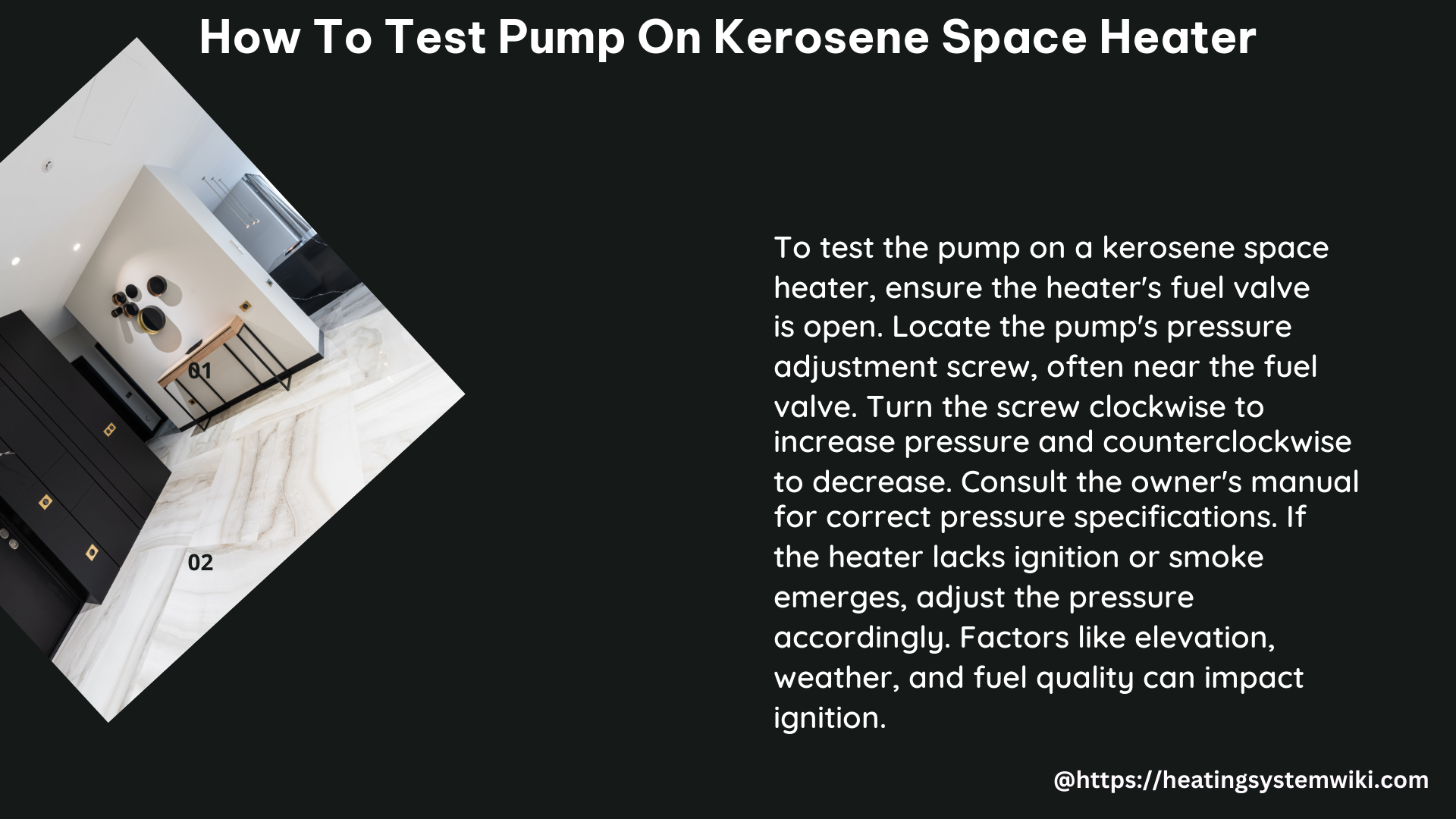Ensuring the proper functioning of the pump in a kerosene space heater is crucial for its safe and efficient operation. This comprehensive guide will walk you through the step-by-step process of testing the pump on your kerosene space heater, providing you with the technical details and hands-on instructions to diagnose and address any issues.
Checking the Air Pressure
The first step in testing the pump is to ensure that the air pressure is within the recommended range. This is crucial for the proper fuel atomization and combustion process. Here’s how to check the air pressure:
- Locate the Air Pressure Adjustment: Refer to the heater’s manual or look for the air pressure adjustment mechanism on the heater itself. This is typically a screw or knob that controls the air pressure.
- Measure the Air Pressure: Use a high-quality pressure gauge to measure the air pressure. The recommended pressure range for most kerosene space heaters is between 5 and 10 psi (pounds per square inch). Make a note of the measured pressure.
- Adjust the Air Pressure: If the measured air pressure is outside the recommended range, adjust the air pressure adjustment mechanism accordingly. Turn the screw or knob clockwise to increase the pressure and counterclockwise to decrease the pressure.
- Recheck the Air Pressure: After making any adjustments, recheck the air pressure to ensure it is within the recommended range.
If the air pressure is still too low, check the air filter, air hose, and air pump rotor for any issues. Clean or replace these components as necessary.
Checking the Fuel Flow

Next, you’ll need to check the fuel flow to ensure that the pump is delivering the correct amount of fuel to the burner. Here’s how to do it:
- Remove the Fuel Filter and Nozzle: Locate the fuel filter and nozzle on your kerosene space heater and carefully remove them.
- Inspect the Fuel Filter: Examine the fuel filter for any signs of clogging or debris buildup. If the filter is dirty, replace it with a new one.
- Inspect the Nozzle: Check the nozzle for any blockages or damage. If the nozzle is clogged, clean it using a nozzle cleaning kit. If the nozzle is damaged, replace it.
- Check the Fuel Line: Inspect the fuel line for any cracks, leaks, or kinks. If you find any issues, replace the fuel line.
- Reassemble the Components: Once you’ve inspected and cleaned or replaced the necessary components, reassemble the fuel filter and nozzle.
Checking the Pump Rotor
If the heater still doesn’t work after checking the air pressure and fuel flow, it’s time to inspect the pump rotor. Here’s how to do it:
- Locate the Pump Rotor: Refer to the heater’s manual to identify the location of the pump rotor. This component is typically located inside the heater’s housing.
- Remove the Pump Rotor: Carefully remove the pump rotor from the heater, taking note of its orientation and position.
- Inspect the Pump Rotor: Examine the pump rotor for any signs of damage, wear, or debris buildup. Look for cracks, chips, or excessive wear on the rotor blades.
- Replace the Pump Rotor: If the pump rotor is damaged, replace it with a new one. Ensure that the replacement rotor is the correct size and model for your heater.
- Reinstall the Pump Rotor: Carefully reinstall the pump rotor, making sure it is properly aligned and seated in its correct position.
Checking the Igniter
If the heater still doesn’t work after checking the air pressure, fuel flow, and pump rotor, the issue may be with the igniter. Here’s how to check the igniter:
- Locate the Igniter: Refer to the heater’s manual to identify the location of the igniter. This component is typically located near the burner assembly.
- Check the Igniter Connections: Ensure that the igniter is properly connected to the heater’s electrical system. Check for any loose or damaged wiring.
- Test the Igniter: Use a multimeter to test the igniter for proper function. Consult the heater’s manual for the specific testing procedure.
- Replace the Igniter: If the igniter is faulty, replace it with a new one that is compatible with your heater model.
Technical Specifications for Testing the Pump
Here are the key technical specifications to keep in mind when testing the pump on a kerosene space heater:
| Specification | Recommended Range |
|---|---|
| Air Pressure | 5 to 10 psi |
| Fuel Filter Replacement | Annually |
| Pump Rotor Condition | No damage or excessive wear |
| Igniter Function | Proper ignition and operation |
DIY Testing Procedure
To test the pump on your kerosene space heater, you’ll need the following tools and materials:
- Pressure gauge
- Fuel filter
- Nozzle
- Pump rotor
- Igniter
Follow these steps to perform the DIY testing:
- Check the Air Pressure: Connect the pressure gauge to the air pump and measure the air pressure. If the pressure is too low, clean or replace the air filter, check the air hose for leaks, and inspect the air pump rotor for any damage.
- Check the Fuel Flow: Remove the fuel filter and nozzle, and inspect them for any blockages. Clean or replace the filter and nozzle as needed. Also, check the fuel line for cracks or leaks.
- Check the Pump Rotor: Remove the pump rotor and inspect it for damage or excessive wear. Replace the rotor if it is damaged.
- Check the Igniter: Test the igniter for proper function. If the igniter is faulty, replace it with a new one.
Remember to always consult the heater’s manual and seek professional assistance if you’re unsure about any of the testing or repair procedures.
